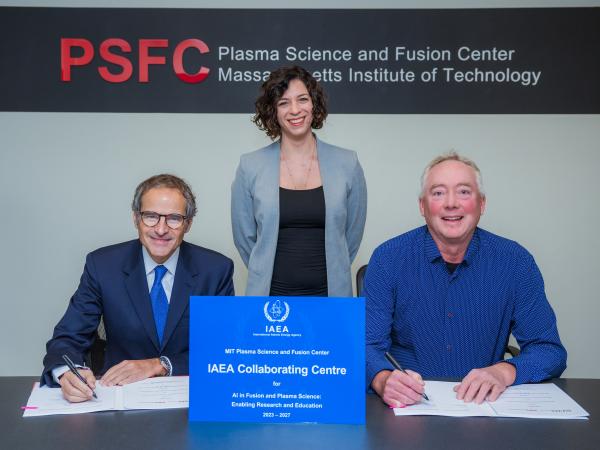
(Left to right) PSFC Group Leader and Research Scientist Dr. Cristina Rea, IAEA Director General Raphael Martino Grossi, and PSFC Director Dennis Whyte met on the morning of September 22nd to sign an agreement designating the PSFC as an official IAEA Collaborating Center. The PSFC is only the second Collaborating Center in the United States, and is the first with a focus on fusion.
Gretchen Ertl
IAEA Director General Rafael Mariano Grossi and PSFC Director Dennis Whyte signed agreement with the PSFC to help realize both organization's shared goals, and advance the IAEA's "AI for Fusion" initiative at the PSFC, which will be spearheaded by Dr. Cristina Rea.
October 27, 2023
On September 22nd, the Plasma Science and Fusion Center was designated a Collaborating Center by the International Atomic Energy Agency (IAEA), the global organization dedicated to accelerating nuclear energy’s contributions to peace, health, and prosperity. Collaborating Centers are institutions that support the IAEA’s mission and initiatives; the PSFC is only the second Collaborating Center in the United States, and the first with a focus on fusion science. IAEA Director General Rafael Mariano Grossi met with the PSFC’s Director Professor Dennis Whyte and Dr. Cristina Rea, the PSFC Disruption Studies Group Leader, to sign the historic designation agreement and tour the PSFC’s laboratories. Director General Grossi later tweeted, “Together, [the IAEA and PSFC will] be exploring and accelerating fusion research with the help of AI, setting the stage for future sustainable energy innovations.”
Dr. Rea first considered the idea of the PSFC becoming a Collaborating Center in 2020, after working with the IAEA on several workshops and publications, including a collaborative paper published in 2022 outlining the ways in which AI and machine learning could be used to accelerate the progress of nuclear science and power. Matteo Barbarino, a Nuclear Fusion Physicist with the IAEA who contributed to the paper, came up with an idea for a coordinated research project that would focus on developing “AI for Fusion” at international scale. That seed grew into the work plan that is at the core of the PSFC’s designation agreement: as PSFC Liaison Officer, Dr. Rea will spearhead efforts to increase access to information on the use of AI in fusion science, and implement educational programs to develop the fusion workforce, in alignment with IAEA mission and goals.
The PSFC’s new designation was featured in the IAEA World Fusion Outlook 2023 publication released during the 29th Fusion Energy Conference, which took place in October. The report states that for an initial period of four years, “…the IAEA will be able to access PSFC expertise in the area of AI applied to fusion and plasma science by bringing together these innovations in an integrated manner, while training a new generation of fusion scientists.”
“I’m honored that the PSFC was chosen as the first Collaborating Center in the field of fusion,” said Dennis Whyte. “Two of the most important things we need to solve fusion’s greatest challenges are diverse partnerships and highly accessible data, which is why our work with the IAEA is so exciting— this is how we accelerate fusion science.”
As a Collaborating Center, the PSFC widens their field of potential partners, especially with those who are located outside of the United States. Additionally, as fusion comes closer to a commercial reality, efforts to regulate the industry are ramping up, and input from fusion leaders is increasingly important. The PSFC’s new role offers more opportunities to interface with regulators and provide feedback on policies as they’re being shaped. Finally, the designation further cements the PSFC’s reputation as a trusted source of information and telegraphs the Center’s commitment to knowledge sharing and cooperation.
Professor Whyte and Dr. Rea would like to thank the IAEA and Director General Grossi for the opportunity to realize the shared goals of the IAEA and PSFC.
(Image: Professor Whyte and Director General Grossi took a tour of the PSFC. Professor Whyte showed the Director General Alcator C-Mod, the PSFC's tokamak in service from 1996 to 2016, and other technologies like high-temperature superconducting tape, pictured here. Photo credit: Gretchen Ertl)
Topics: Magnetic fusion energy